|
FAQs about Predators & Pests of Soft Corals of the
Family Alcyoniidae
FAQs on Alcyoniid Disease:
Alcyoniid Health 1,
Alcyoniid Disease 2,
Alcyoniid Disease 3,
Alcyoniid Disease 4,
Alcyoniid
Disease 5, Alcyoniid
Disease 6, Alcyoniid
Disease 7, Alcyoniid
Disease 8, Alcyoniid
Disease 9, Alcyoniid Health 10,
Alcyoniid Disease 11, Alcyoniid
Health 12, Alcyoniid Disease 13,
Alcyoniid Disease
14, Alcyoniid
Disease 15,
FAQs on Alcyoniid Disease by Category:
Diagnosis,
Environment,
Nutritional, Pathogenic (Infectious,
parasitic), Social, Trauma,
Treatments
Related Articles: Soft Corals of the Family
Alcyoniidae
Related FAQs: Soft Corals of the Family Alcyoniidae,
Alcyoniids 2, Alcyoniids 3, Alcyoniids 4, Alcyoniid ID, Alcyoniid Selection, Alcyoniid Compatibility, Alcyoniid Systems, Alcyoniid Behavior, Alcyoniid Feeding, Alcyoniid Propagation, Soft Coral Propagation, Soft Coral Health, Dyed Corals, Soft Coral Propagation, Nephtheids, Dendronephthya, Paralcyoniids, Nidaliids, Xeniids, Dyed
Corals,
|
|
|
Worms on green leather 8/7/17
Does anyone know what these tiny worm like things are on my leather, they are
about 3 or 4 mm long and seem to have speckled brown ends, they don`t seem to
move but they look like they are something which has hatched out or is burrowing
into the flesh, are they some kind of parasite? How do I get rid of them or are
they just part of the leather?
Thanks Jackie
<Can't make out... but this Alcyoniid looks in poor health. Might be something
consuming it as it dies.
Bob Fenner>
|
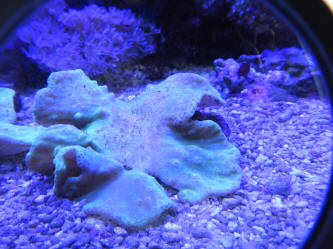 original
original
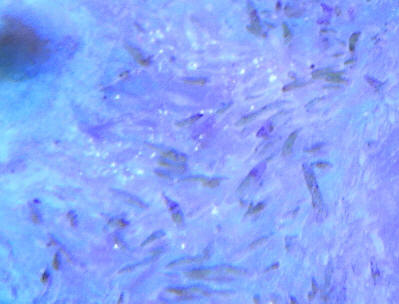 Cropped, spiffed
Cropped, spiffed |
|
Finger leather disease
12/20/12
Something seems to be eating my finger leather it is like a black web.
<Does appear to me as well>
I noticed it first on one of the fingers and have since removed it and
recently rotated the piece to discover that whatever it is has made a big
dent in the base as seen here.
<Mmm, could be worm/s, a type of Mollusc, even some fishes will chew a hole
like this>
Given your experience would it be best to frag the healthy fingers off,
attempt to treat it, or attempt to cut off the dying chunk in the base?
<A part of the base is best... In this case, just cutting the animal above
the chewed, damaged area, using an iodide-ate dip/bath, tying the
Alcyonacean down to a hard/rock base, per what is posted on fragging/asexually
reproducing soft corals on WWM. Bob Fenner>
<Of course, you need to determine the cause/source of the damage and
correct/remove it>
|
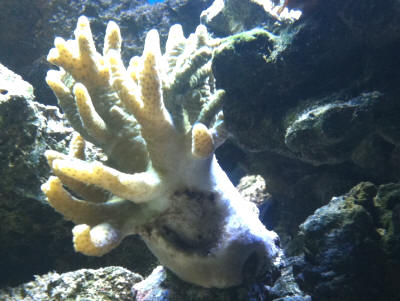 |
Re: Finger leather disease
12/22/12
On that note I have a bit of a strange question. I have not had much
success with iodine dips before and happen to have a ton of ground kelp
sitting around the house which dissolves in water and is rich in iodine.
<Interesting... in our town (San Diego), was a company (Kelco) that has
traded hands quite a few times... that extracts alginates (emulsifiers)
from some of the large Phaeophytes (brown kelps/algae) harvested off the
coast... I don't know http://en.wikipedia.org/wiki/Iodine that Iodine
(actually iodide) is collected in the process, but it can be
(http://en.wikipedia.org/wiki/Iodine )...>
I'm wondering if I mix kelp into a container with the water and keep the
coral in that water for a bit whether it would have the same or similar
effect. The damage seems to be increasing and I have not observed
anything in the tank biting the coral so I suspect it is some kind of
fast acting algae or fungus.
<I would get/use a commercial prep. I am particularly fond of the
SeaChem line (real products en toto, consistent in make-up)...
Iodide-ate is very safe used as directed. Bob Fenner> |
|
Leather Pests? 4/17/12
Hi WWM,
<Amy>
We woke up this morning to find our leather closed up and these little
spiked things sticking up all over on it!
<Bizarre!>
I've been trying to search all morning to find out what they are but I've
had no luck!
They don't seem to be moving and are small, probably a few millimeters in
length only. I've attached a photo for you!
Hope this is something you've seen before and can tell me what I should try
to fix the problem!
Thank you!
Amy :)
<Due to their sudden appearance and distribution, am guessing these are part
of the soft coral itself... some sort of reaction to... another Cnidarian?
Water quality change? I'd be changing out a good deal of the water, possibly
utilizing carbon... and reading here:
http://www.wetwebmedia.com/AlcyDisF15.htm
Was another stinging-celled life organism added recently? Showing a
difference in appearance, behavior?... It may need to be removed,
re-acclimated... Search WWM re allelopathy. Bob Fenner>
|
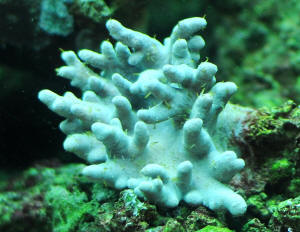
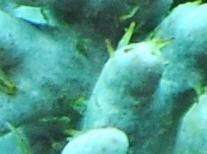 crop
crop |
|
Sinularia with weird "breathing hole"
11/16/11
Hi,
I've a problem with my Sinularia sp...it doesn't look
poorly but it's shedding more often than normal.
At a close look I found a weird hard "cannula"
protruding from stalk, it seems a "breathing hole" of
some endoparasite.
<Mmm, new to me>
Pics will be more eloquent.
What kind of parasite is it?
<I would risk (not big) cutting this out... some single edge
razor blade cuts from the opening edge out>
Thanks,
Manuel Ricci
<Do please follow up w/ your further observations. Bob
Fenner>
|
|
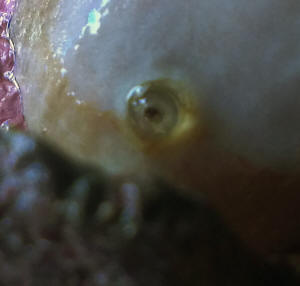 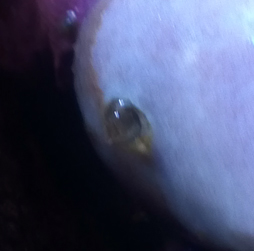
|
| Growth on coral question 3/5/08
Hi, My colt coral has a white growth on the side of it. I have
noticed since it started growing about 2 1/2 months ago, the health
of my colt has been off. I'm not sure if it really has anything
to do with my colts health or not, but it showed up at the same
time it started not doing as well as it had been. ( I have had the
coral for 5 months) Thought I had lost it about a month ago, but it
is slowly bouncing back and is feeding more hours a day.
<Good> The white patch also "grows and shrinks"
during the day like a coral does. This patch has also really had a
growth spurt in the last 2 weeks. Insight anyone, to what this
might be...good or bad? Sal. 1.025 Calcium 460 Alk 5 PH 8.2 Nitrite
0 Nitrate .02 Ammonia 0 Silicate 0 Phosphate 0 Thanks for any info,
Katie <I would look closely... perhaps a Nudibranch predator at play
here... Could be an ongoing infectious agent... there are folks
(esp. commercial) who would "cut to the chase" and frag
this Alcyoniid, excising the troubled area. Please read here:
http://wetwebmedia.com/alcyonpropfaqs.htm Bob Fenner> |
|
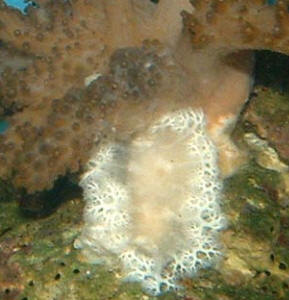 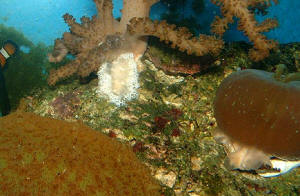 Nudi. RMF. Nudi. RMF.
|
|
Re: Hey Bob, its Niki. Got an anemone
question here. Actually, now a predaceous Nudi. on Sarcophyton
(elegans?) 11/21/07 You are the best! That site rocks.
Thanks, Bob. One more question...have you ever seen/heard of a
'Yellow Fiji Umbrella' specific Nudibranch? <Mmm, have
been to Fiji a few times, diving... seen yellow Nudibranchs
there... Do you have a pic?> I found a few Nudis the same
exact color of the coral latched onto some very unhappy Sarcos.
<Bad... should be physically removed, search the soft corals
for egg packets, those removed as well> They reminded me very
much of smaller versions of the larger white Nudibranchs that we
find on the Sinularias and such. The difference is that they
mimic the yellow color of the umbrellas, much like the
Nudibranchs found on P. cylindrica. I do have pics if you need to
see them. Thanks, Niki <Please do send these along... have
collected, and discourage the collection of the "Yellow
Sarcos" from here, and Tonga... as for whatever reasons (I
know naught) they don't often live for long... but have been
so inobservant as to not notice these apparent predators. Be
chatting, BobF>
Re: Niki here, w/ pic of our little yellow friend. Nudi
feeding on Sarcos... 11/22/07 So here's the
culprit. <Ah, yes. Nice pix> I found about 10 or so
embedded very deep in the tissue, all hidden very cleverly within
the ruffles of the Fiji Yellows. The only reason they came to my
attention was the fact that I was treating all of my Alcyonaceans
with Levamisole Hydrochloride due to a rampant infestation of the
run-of-the-mill white Nudibranchs, mostly on my Sinularias. The
little yellow guys started bailing off. I have included a pic
next to the other Nudibranch so you can get a feel for the size.
<Yes... reports up to 1"> The white Nudi is almost an
inch long. All of the yellow ones were about the same size. Let
me know what you think, thanks again, Niki <Mmm, I do think
you are wise to be using a dewormer. Look for the spiral egg
masses... and remove them as well. Cheers, Bob Fenner>
|
|
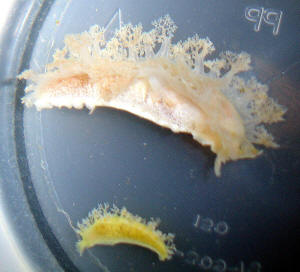
|
| Pics and ? Nudibranch and polyp/anemones
3/28/07 Hi there to all the crew. My name is Tracey. I have a
125 gallon reef tank and have for about 13 years now. I have two
things I would like to address here. First, I have a couple of colt
coral that started suddenly not doing well. Like they were being
stung, <Consumed, predated...> but nothing was near enough
even with current that would make that probable. I needed to top
off my water and added my upped the alkalinity just enough to
irritate the critter that was causing the problem to come into
view. I am attaching a pic of this beautiful guy which I think is
maybe a Nudibranch? <Yes... at least a Opisthobranch/Seaslug...> I'm surprised to see this now as I
have not added anything new in months. I took him out and place him
in quarantine until I learn more. I have seen and removed these
before quite some time ago, and they had more of a pink color but
were smaller. This guy is about 1 1/2" long and 3/4"
wide. I removed him with tweezers and he had a sticky and slimy
substance left behind what ever he came into contact with. I have
found them near the base of the colt only. I'm not seeing flesh
decay of the colt, it looks more like it being stung though I'm
not certain. The base of the colt looks like it is separating some
from the rock. He looks better already after only an hour of
removing him. <Is/was being chewed... keep your eyes peeled for
others> Ok, my next issue is this. I have several different
polyps in my tank and have had a new species of some sort pop up
and they multiply quickly. They split in half and they just move
around and make more, even through the current. They grow on the
glass, in the sand, on the rocks like crazy, and I have seen them
grow attached to other coral. I'm wondering if this is some
type of anemone rather than polyps. <Mmm, some pix look like
Zoanthids... others summat like Anemonia species> I did have an
Aiptasia problem and got that problem under control, so I'm
pretty sure that's not what these are. I took out a few rocks
that are just covered in about a months time and quarantined them
also. I'm sending a few pics of these as well. Thanks in
advance for your time and help. I love this site. Tracey <Do
take a scan on/over WWM re these species... best to not let
proliferate/cover too much of your LR. Bob Fenner> |
|
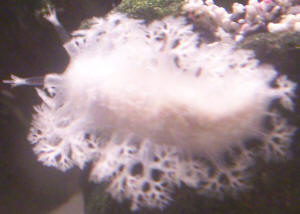
|
Leather coral eaten? - 1/24/08 Hello Bob and crew!
<Thanasis. Tee ka'nees?> It has been a long time since our
last contact and I would like to say a big "thank you" again
for your great help in setting up my first reef aquarium 3 years ago.
<Welcome> I have a problem with a Sarcophyton, which I purchased
3 months ago. It has never seemed to be feeling well in my tank, but
since 10 days now it looks like it has been eaten by some fish or
perhaps it has started to dissolve, I am not sure what is going on. Two
days ago I treated it with reef dip (Seachem) but the situation has not
changed. <Mmm, I would move it elsewhere... carefully look about it
to see if there is a predator present (perhaps a snail, worm...)> I
have a Clarkii clown, a Loreto, a Bird wrasse a damsel and a Blue Tang,
two Sinularia thriving and many Discosoma and two Crispa anemones (far
from the coral). <Mmm, these last could be an influence here> I
am attaching a photo of the coral. <Mmm, nothing attached> Tank:
240 lit + 50lit sump-refugium (lots of macro algae) PH 8,4 -8.75 RedOx
320mV Calcium : I can not measure it with the test I have, I have to
buy another test kit Alkalinity: 10 kH 2 skimmers (1 Remora, 1 MCE-600
Deltec + ozonizer) Lighting: MH 250W 10.000k <Ideally, place the
Sarcophyton in a bare/empty tank on a "pedestal" so it can be
more easily observed> 2nd question: what if I bought another
clarkii? Would he make the other anemone his host and live in peace
with my other Clarkii ? <Mmm, more likely there would be trouble
between the new and established Clowns... unless this tank is very
large (hundreds of gallons) I would not risk this> Thanks again for
the assistance Thanasis , your Greek friend (I could not attend the
lecture of Antony Calfo at Athens, but I was informed by other members
of our Greek Aquarist Board that it was fantastic!) <Ahh! Will send
on to him. Bob Fenner>
Finger Leather problem
5/24/06 Hi, I have a 90 gallon reef tank using about
500watts of T5, 100lbs live rock, refugium (plants & live sand),
and all parameters are in check and constant - the system has been
running for over 2yrs. What I've noticed over the last 2
weeks, is my Finger Leather that has been flourishing, began to turn a
slightly different color in some areas and now it looks like some small
cuts/holes are appearing. :( I have identified (at least I
think I've identified) flat worms in my system. I've
had this before, but through water changes and siphoning they seem to
go undetected. My concern is, these multitude of small
reddish/flat organisms are not what I think and that they are damaging
my Finger Leather. <Possibly, but not likely the cause of the cuts
you mention> No other coral/fish is showing any signs of
distress. I'm not a big fan of using something like
flatworm exit because I've heard stories where things can go really
bad with so many organisms dying... <Yes, this is so> and from
what I've been told and read, flatworms shouldn't cause
corals/fish any problem. Is that true? <Yes> Any help
suggestions you can offer would be greatly
appreciated. thanks! Shawn.
<Mmm, could be a number of things at play here (other pests,
chemical warfare of sorts...), but the easiest, most direct action is
to remove/place this soft coral elsewhere if you have another system.
If not, a stop-gap measure of water change, activated carbon use,
addition of Lugol's... will likely resolve this situation
temporarily. Bob Fenner>
Re: Sarcophyton Health (Nudibranch!) 4/1/06 A
quick update. The Sarcophyton seemed to quit recovering and
continued to slough very frequently. Meanwhile, the white
spot at the bottom became obviously necrotic. I was still
thinking allelopathy and doubled the skimming (added an AquaPro hang on
skimmer since I read bad things about the RedSea skimmer I was using on
WetWebMedia) and left the Sarcophyton alone. I figured the
water quality measures couldn't hurt. Since then, all
corals have been growing noticeably each week, (including another green
Sarcophyton) except for the sick Sarcophyton which continued to spend
most of its time sloughing off. The necrotic area appeared
frayed and growing. I finally decided to remove the coral,
cut out the dead tissue and look for parasites. What I found
appears to be a small, white, 1cm Dendronotid sp. Nudibranch. I
don't have much salt water experience, but that's my ID based
on my invert reference book. So, mystery solved.
<Ahh, good to hear.> I removed the Nudibranch and scraped/cut off
all necrotic tissue with an Exacto knife. The knife was not
as sharp as I would have liked so I left a film of white tissue in
place rather than torture the animal more. The remaining
tissue all seemed firm anyway. I shook it inverted
vigorously in a container of tank water and returned it to its
spot. It immediately stood more erect than it has in two
weeks and started extending polyps in under an hour. I found
this amazing after such torture. Anyway, my question is,
other than dosing iodine, water changes, etc'¦ is there
anything else that I should do to help the recovery? Will
the remaining film of white skin slough off naturally with the next
sloughing cycle? <Should. Time will heal this,
continue providing good water quality and all should be well.>
Thanks for your help and your site. WetWebMedia FAQs help
tremendously when trying to work through these things as a
beginner. <That they do Brett and glad to hear your
problem is solved.> Thanks. <You're
welcome. James (Salty Dog)> Brett
Leather Coral Health 11/21/05 Hi
Guys, Been reading your Website for about six months now. Very
helpful. First time question. I've had this leather coral
for about 1 month. It had been expanding nicely, but only for short
periods of time, then it stopped expanding. After day 5 of not
expanding, I checked it out when the lights were out. Should of
done this sooner (duh). <<"Should have",
not "should of" - sorry, I have a friend who does this
all the time! MH>> Found a Dendronotus sp. or
Tritonia sp. on the base of the coral. I extracted the sucker with
a tweezers and softly brushed the rock rubble it was on for
possible eggs in a bowl of display water, and put it back in. This
morning It looked like this (see pict.) and hasn't changed. Is
it dying? <Maybe...> Or will it come back? <Hopefully>
Is there anything I can do? <Optimized, stable water quality,
iodine/ide administration (Lugol's), feeding...> All my
others corals are fine. and water is optimum. Thanks,
Tom C.
<Welcome. Bob Fenner> |
|
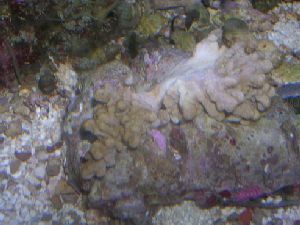
|
Pods... undesirable7/5/05 Hi WWM, Recently
I'm seeing "ant-like" pods burrowing in my live rock and
some of my coral. Two of my soft corals look sick and these pods are
crawling in and out where the tentacles of the coral are supposed to be
sticking out. Are these pods harmful, <Could be> they seem to
come out of their hole just for a split second and look like small
red/black ant about the size of 2mm. I freshwater dip one of my live
rocks and a whole bunch of them came out swirling, struggled and die in
about 15 seconds. Thanks and keep up the good work. Regards, Yik Sing
<You might want to look into adding a fish predator that will
eliminate a bunch of these crustaceans. There are many choices. Bob
Fenner>
Toadstool Leather disease, possible predation I
have a toadstool leather that is about 3 years old. Over the
past couple of weeks I have noticed a hole forming in the
cap. The hole is slightly smaller than a dime and is
currently about 1.5" deep. When it first began it
looked like detritus was sitting on the cap. I blew it off,
but a day or so later it was back. It does not appear to be
spreading, just getting deeper. I have not noticed anything
in the hole that would be eating it. I am about to get in there and cut
the flesh around the hole out to see if that takes care of
it. But found your site and wanted to see what you suggest
Thanks, Steve <I suggest close/r observation... I fully suspect you
have a predator at play here... possibly just a large Polychaete
(bristle) worm... Do use a flashlight to peek in at night... consider
netting, trapping out this animal... possibly isolating the soft coral,
the eventuality of maybe needing to excise the damaged portion,
possibly fragmenting it entirely. Bob Fenner>
|
Stranded Hydroid! Yikes! 4/7/05 Hello WWM
Crew, <howdy> I have a quick question for you regarding a
finger leather and a strange set of tentacles coming from it.
<yikes! they are not from the leather, but instead are from a
stinging hydroid. They can be quite aggressive to other reef
creatures and even burn your skin painfully> I have attached a
picture of identical tentacles as what are coming from
my leather but am unsure of how to deal with this issue.
<manual removal> I have only had the leather for 3 weeks
now and it has never extended a single polyp. <Perhaps
it's irritated from the hydroid. More importantly... I fear
you have added this coral to your tank without a proper
quarantine period. Yikes, if so... it's a surefire way to
introduce pests and predators to your tank like this hydroid>
Every evening these threads come out and they are very intricate
which is what led me to believe they were not just mucous. I
cannot see anything on the leather itself by following
the threads but there are 6 or 7 coming out. Any help you can
give me would be greatly appreciated. Regards, Scott B. <There
are many types of hydroids in the world. Some look like corals...
some look like algae... others more like jellyfish. Caution with
all :) Anthony>
|
|

|
Sick toadstool coral - parasite? Hi Crew, <Hey Matt> My
toadstool coral appears sick. Please see attached pic. He closed up
last week, and hasn't come back out since. <Not unlike a
toadstool to do this, but.....> There are what appears to be bite
marks on its flesh. <Possible stinging, poisoning, or is a
clownfish taking up residence in it> There is a Clarkii clown in the
tank that has began living in the coral the last few months as though
it were an anemone. <I see> Is it possible that he is responsible
for the damage? <Yes. Clownfish do bite to stimulate the anemone at
times. Check out our forums and ask around in there for more specific
information. Keep an eye on the toadstool however, as it has been noted
there are some mollusks that burrow into the crown or stalk of this
coral and feed from the inside out. May look unsightly, but keep your
water quality up and clean out the wound with a syringe or turkey
baster and I feel the coral will make a full recovery. Sarcophyton
corals are extremely hardy and resilient.> Or is there some other
forces at work? <Possible. These corals are also known for closing
shop for a few couple of weeks and shedding floc (chemical build-up,
digested foodstuffs, etc.) during growth periods. Keep an eye on it and
send us an update. Keep a journal if possible. You know, something to
reference at a later time just in case you see something like this
again. I just thought of something......... I remember Sally Joe over
at Graford working to connect clownfish to Sarcophyton corals. Do some
research on their site before calling them as they are with limited
abilities, trying to save money. (Aren't we all) If you can't
find anything specific to your situation then give Lionel a call. I am
sure he can relate some stuff he has seen or has heard discussed around
the shop. www.garf.org -Paul> Everything else in the tank is doing
great. <Glad to hear> Cheers, Matt
Sick toadstool reply - 7/31/03 Thanks for the reply -
I'll check it out right away. <Very well> The coral has
actually got quite poorly ..... it is now drooping over, actually bent
(kinked) in the middle .... although it is trying to extend the polyps
a little bit. <This is actually a good sign. Is the clown
still using this coral as a home? If so, I would remove the coral if
possible. Keep the harassment to a minimum. Again if it is extending
polyps (even if only partly) then there is hope. > I moved him to a
position in the tank where he'll get a bit more water flow across
him, <Careful> in hopes it might resuscitate him or something
..... though it hasn't made any difference. <Keep an eye
on it. Give it time and keep high water quality through a regular water
change regime. Don't fuss with it much or move it around. Give it
time> I'll take a look at that site and hopefully some one there
will be able to help. <Well, in my original email, I meant to
do research and identify the interaction of corals and clownfish. More
to help and identify if others have had any observations of bites taken
out of their Sarcophytons by resident clownfish. There, unfortunately,
is no magic recommendation to suddenly turn this corals health around.
Water changes and remove every possible hazard as best you can is a
good path to recovery. More help in the form of ideas is better though.
Good luck -Paul> Cheers, Matt
Toadstool recovery - 8/7/03 Dear Paul, <Yep, yep, yep>
You asked me to keep you updated about the toadstool coral. <I did.
Thanks for coming through, Matt!> Well, the last week or so he seems
to be getting better. <Yeah. Very good to hear! I did a little
research and the yellowish markings around where the damage took place
is just a reaction from the coral (kind of like bruising.) Heals really
quick. the actual chunks missing could be caused by a coral sting or a
bite from a fish. (at least the damage looks consistent with my
findings)> Although he hasn't opened up fully again, he is
none-the-less opening up a lot more <A resilient coral
indeed>.... I'd say he's opening about 60%. The only
conclusion that I have come to, based on both my "notions"
and on what other folks have said or suggested is this. The Clown took
up residence in the coral. Clowns sometimes bite at anemones to
'stimulate' them. Why they do this I do not know, but
apparently they do. So, when my mushroom shrunk up, as they naturally
do once in a while (I am told), the clown started to bite what he
thinks is an anemone in an attempt to make his "anemone"
expand again. <As stated in our previous conversations> I just
added 2 and 2 together and got 5!!! <Math is funny!> Assuming
that the bite marks were damage and this was what caused it to contract
...... rather than the coral contracted and this is what caused it to
be bitten. <More the latter, probably.> Now that it is starting
to expand again, and I am assuming that there was in fact nothing wrong
in the first place, I have relocated the toadstool to its original
location - which no doubt will make it contract for the day. But in the
mean time, in the last few days, when the coral was opening up again,
the clown once again took up residence in it. <Yep. Need to keep an
eye on this if not straight away remove the coral or the clown.> I
am now fairly confident that the coral will open up again, and the
minor damage caused by the clown will heal quickly and fully.
<Absolutely.> Thanks for your input. I'll let you know if and
when it has returned to its former glory - will send you a pic then of
coral and resident clown. <Very good. Did you ever get a chance to
talk with Leroy or Sally Jo Headley of GARF? they are very interested
in this kind of surrogacy. Thanks for the update. This is a valuable
email. Take care - Paul> Cheers, Matt
Distressed Leather? (Removing An Aiptasia From a Leather
Coral) Greeting WetWeb Crew! <Hi there! Scott F. here
tonight!> Kudos to you all, for the time and effort that is put into
this site. It helps people like me to better enjoy and appreciate this
great hobby. <We're thrilled to be here for you...We have as
much fun answering your queries as we do playing with our fish!>
I've been reading your site now for about a year and have a 90
gallon marine tank for almost as long. My question is about a beautiful
new mushroom leather coral I just purchased -Sarcophyton. The crown is
about 4 to 5 inches across and is attached to an approximately 2 inch
thick "stalk", about 3 or 4 inches long. On the very bottom
the stalk is a piece of rock about the size of a quarter. Wedged
in-between this piece of rock and the coral are a couple of nasty
Aiptasia. Eeek!! If I am very careful, with a sharp scalpel, or
Exacto-knife, could I or should I slice a very thin layer of the coral
just above the rock, taking the Aiptasia with it? <I have
experienced a similar occurrence with a Sarcophyton, and was surprised
how easy it was to remove the Aiptasia without damaging the coral. The
base of the Sarcophyton is surprisingly "tough", and you can
practically scrape the anemone off of the coral without damaging
it.> If so, what treatment should follow? <My best advice is to
simply maintain very good water quality after this
"procedure"> I have read in Anthony's Coral
Propagation book that these corals are quite forgiving. I value your
advice. What do you think? Thanks in
advance, Brenda. <They are very forgiving! As Anthony and
others have implied, you can practically run 'em through a blender
and end up with a new coral. However, they do deserve the highest level
of care we can offer, so try to be careful when conducting this
"operation". Good luck! Regards, Scott F.>
Lobophytum Issues - 4/11/03 Greetings guys <Hiya. Paul
doin' my best>... I have a new Lobophytum (purchased 3/23/03) in
my tank. Up until tonight it had been expanded nicely, and a beautiful
golden/pink/brown color, with polyps coming out whenever I checked on
it. Tonight, within about an hour, this coral shrank to about half
it's original size, and turned an equally beautiful shade of
purple. <Does happen if something mucked with it or touched it
recently. Are other corals near? Fish? Sometimes does happen. Since you
sent this a few days ago, has the situation changed at all?> The
only thing that has changed in my tank is that on 4/6, I began to drip
Kalk to help raise my calcium levels. <Could have something to do
with it being so low and then going up, but likely would have noticed a
change in the coral relatively soon after the addition of Kalk not a
few days later. How are ya' doin' on your water changes?>
I've been using B-Ionic (60 ml/day, each part) for a few months.
The tank was started on 10/4/02 with live rock. I began to add fish and
corals on 2/16. They consist of two clowns and a yellow tail damsel.
The other corals are a small candy cane, and some green star polyps.
Water param.s tonight: Temp - 80.2 pH 8.2 SG 1.025 Ammonia 0.0 Nitrite
0.0 Nitrate 0.0 Phosphate 0.0 Calcium 310 <LOW!!!!!> KH 9 <A
little low> A little more background - I'm skimming with an ETSS
800 Gemini with an Iwaki 55RLT. Water is turned over by a T4 (about
1100 gal/hr) plus 2 300 gph power heads pulsed on and off randomly. Any
thoughts about the devils hand that so radically turned? <Hard to
say> Is this a recoverable situation or have I lost it? <very
likely not lost at all. Water changes, time may be all the difference.
Let me know what you find, and how it turns out> Thanks in advance.
<Look to hear from you soon. Thanks for your question and sorry for
the lack of a definitive answer, but hard to say. I would not want to
put it all on the Kalk. My Lobophytum will sometimes change appearance
and shape after tank cleanings, or if something touched it (darn
hermits) etc. Keep an eye on it and let me know if it returns back to
normal. Pablo> D.T.
Lobophytum follow-up - 4/11/03 Thanks a lot for your reply.
<Sorry for its lateness> Since I wrote to you in a panic that
night, the lobo has changed for the better. <Well, I figured it
would> Just before I went to bed that night, I peeked in again, and
thought that it seemed to be a little fuller looking, but didn't
want to get my hopes up. The next morning, it was looking 95% better,
and last night it's back to it's old self. <Yeah either
something bumped it (from a snail on up) It's polyps are out and
looking good. <Very well> It is next to a candy cane coral, and
the fish do have access to it. <Hmmmmm> Maybe a sweeper from the
candy cane touched it? <Could be. I would keep an eye on it if you
think there might be a problem.> I don't know. In the
rec.aquaria.marine.reefs group, a couple of guys said that their
Lobophytum do a similar thing once in a while, but then come back to
normal. <I, too, have had similar experiences.> I'm relieved.
<Cool> Thanks again for your reply. <My pleasure and sorry for
its tardiness> I enjoy your site and trust your answers. <Thank
you for your question. Paul> Sincerely Dave Town
Leather Coral feeling poorly! 6/11/03 Hi Anthony, Hope you
and all the crew are well! If you don't mind I have need of your
advice again. <cheers, Jenny... good to hear from you> If you
remember I asked you a while ago about the hard cancerous patch in the
centre of my toadstool leather coral. It had been caused by my two
percula clowns constantly swimming and living in the corals polyps. You
didn't think at the time that it would be harmful but now there
seems to have developed a big deep hole in this calcareous patch and
the coral is very unhappy. <interesting... and indeed in need of
address.> There are also yellow spots/small patches appearing in
places on the coral, these show up clearly because the coral is hardly
extending it's polyps now where as before they were always out. The
coral is also shrinking in size and I wondered if there is something I
can do to stop this determination. <clearly the coral and clowns
need to be separated. I personally have never liked clowns in a reef
aquarium... they often take even less suitable hosts like LPS corals
and kill them. Yet... if you are attached to the clowns, we might
simply pull the leather and hope they take a cave next> Everything
else in the tank appears to be fine and the only parameter that is not
as it should be is the ongoing phosphate problem I have always had and
that is gradually diminishing with regular RO water changes. I
don't think this is the problem though as this coral has lived
happily in this environment for a very long time. <agreed... re:
such hardy leathers & phosphate> I think the clowns have caused
the damage and am thinking of trading them in but wondered This coral
can be revived. <yes... easily> Have you any suggestions that
might help? <worst case scenario, the necrotic patches can be cut
out with a razor or scalpel> There have been no new additions of
either fish or inverts to this tank in the last 6 months and it gets
regular water changes of about 15% every 2 weeks. <all good :) >
Many Thanks - Jenny P.S Do you know when the new book is going to be
dispatched? I'm really looking forward to it arriving! <yes...
very soon my friend. They have trucks scheduled to begin shipping it in
the US the last week of this month. Hoping you'll see your arrive
by airmail to UK early July <G>! Kind regards, Anthony>
Toadstool Leather Plaque Bob, <Anthony Calfo in your
service> I have a Toadstool Leather that has always done very well
in my aquarium. However, recently I noticed an outbreak of something on
the upper part of the “stalk” part of the specimen. It
looks like small deposits of a plaque-like substance. It is white in
color and porous to the touch. It can be rubbed off but it leaves a
white “scar” on the flesh. The Toadstool still stands up
straight, but it hasn’t opened its’ little tentacles since
I noticed the outbreak. I haven’t been able to find any
information that addresses this problem. Please help. Kelli
<somewhat general symptom... could be several things. If
superficial... could be an incidental sponge or other invertebrate
taking residence. If indented, then my suspicion is that it is not
pathogenic but rather pest (fish bites, segmented worms, flatworms,
etc. nipping and causing necrotic patches). Do observe polyp extension
normalcy... if retracted uncommonly for its nature (leathers can have
polyps out day and night) pay attention to that photoperiod for a
predator. Look closely even with a magnifying glass for camouflaged
flatworms. Best regards, Anthony>
|
|

